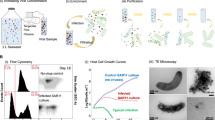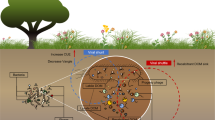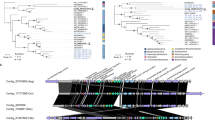Abstract
Viruses contribute to the mortality of marine microbes, consequentially altering biological species composition and system biogeochemistry. Although it is well established that host cells provide metabolic resources for virus replication, the extent to which infection reshapes host metabolism at a global level and the effect of this alteration on the cellular material released following viral lysis is less understood. To address this knowledge gap, the growth dynamics, metabolism and extracellular lysate of roseophage-infected Sulfitobacter sp. 2047 was studied using a variety of techniques, including liquid chromatography–tandem mass spectrometry (LC-MS/MS)-based metabolomics. Quantitative estimates of the total amount of carbon and nitrogen sequestered into particulate biomass indicate that phage infection redirects ∼75% of nutrients into virions. Intracellular concentrations for 82 metabolites were measured at seven time points over the infection cycle. By the end of this period, 71% of the detected metabolites were significantly elevated in infected populations, and stable isotope-based flux measurements showed that these cells had elevated metabolic activity. In contrast to simple hypothetical models that assume that extracellular compounds increase because of lysis, a profile of metabolites from infected cultures showed that >70% of the 56 quantified compounds had decreased concentrations in the lysate relative to uninfected controls, suggesting that these small, labile nutrients were being utilized by surviving cells. These results indicate that virus-infected cells are physiologically distinct from their uninfected counterparts, which has implications for microbial community ecology and biogeochemistry.
Similar content being viewed by others
Log in or create a free account to read this content
Gain free access to this article, as well as selected content from this journal and more on nature.com
or
References
Ankrah NYD, Budinoff CR, Wilson WH, Wilhelm SW, Buchan A . (2014). Genome sequence of the Sulfitobacter sp. 2047 infecting lytic phage pCB2047-B. Genome Announc in press.
Bajad SU, Lu W, Kimball EH, Yuan J, Peterson C, Rabinowitz JD . (2006). Separation and quantitation of water soluble cellular metabolites by hydrophilic interaction chromatography-tandem mass spectrometry. J Chromatogr 1125: 76–88.
Bancroft FC, Freifelder D . (1970). Molecular weights of coliphages and coliphage DNA. J Mol Biol 54: 537–546.
Bennett BD, Kimball EH, Gao M, Osterhout R, Van Dien SJ, Rabinowitz JD . (2009). Absolute metabolite concentrations and implied enzyme active site occupancy in Escherichia coli. Nat Chem Biol 5: 593–599.
Bennett BD, Yuan J, Kimball EH, Rabinowitz JD . (2008). Absolute quantitation of intracellular metabolite concentrations by an isotope ratio-based approach. Nat Protoc 3: 1299–1311.
Benz R . (1985). Porin from bacterial and mitochondrial outer membrane. Crit Rev Biochem Mol Biol 19: 145–190.
Berg JM, Tymoczko JL, Stryer L . (2012) Biochemistry. W.H. Freeman: Basingstoke.
Bratbak G, Jacobsen A, Heldal M . (1998). Viral lysis of Phaeocystis pouchetii and bacterial secondary production. Aquat Microb Ecol 16: 11–16.
Breitbart M . (2012). Marine viruses: truth or dare. Ann Rev Mar Sci 4: 425–448.
Brussaard CPD, Wilhelm SW, Thingstad F, Weinbauer MG, Bratbak G, Heldal M et al. (2008). Global-scale processes with a nanoscale drive: the role of marine viruses. ISME J 2: 575–578.
Buchan A, Gonzalez JM, Moran MA . (2005). Overview of the marine Roseobacter lineage. Appl Environ Microbiol 71: 5665–5677.
Budinoff CR . (2012) Diversity and activity of roseobacters and roseophage. PhD dissertation, University of Tennessee: Knoxville, TN, USA.
Budinoff CR, Hollibaugh JT . (2007). Ecophysiology of a Mono Lake picocyanobacterium. Limnol Oceanogr 52: 2484–2495.
Calendar R . (2006) The Bacteriophage. Oxford Uninversity Press: New York.
Chan LK, Newton RJ, Sharma S, Smith CB, Rayapati P, Limardo AJ et al. (2012). Transcriptional changes underlying elemental stoichiometry shifts in a marine heterotrophic bacterium. Front Microbiol 3: 159.
Chen F, Wang K, Stewart J, Belas R . (2006). Induction of multiple prophages from a marine bacterium: a genomic approach. Appl Environ Microbiol 72: 4995–5001.
Coon JJ, Ueberheide B, Syka JE, Dryhurst DD, Ausio J, Shabanowitz J et al. (2005). Protein identification using sequential ion/ion reactions and tandem mass spectrometry. Proc Natl Acad Sci USA 102: 9463–9468.
de Hoon MJL, Imoto S, Nolan J, Miyano S . (2004). Open source clustering software. Bioinformatics 20: 1453–1454.
Fiehn O . (2002). Metabolomics–the link between genotypes and phenotypes. Plant Mol Biol 48: 155–171.
Flynn KJ, Dickson DMJ, Al-Amoudi OA . (1989). The ratio of glutamine: glutamate in microalgae: a biomarker for N-status suitable for use at natural cell densities. J Plankton Res 11: 165–170.
Friedman S, Gots JS . (1953). The purine and pyrimidine metabolism of normal and phage infected Escherichia coli. J Biol Chem 201: 125–135.
Gobler CJ, Hutchins DA, Fisher NS, Cosper EM, Sanudo-Wilhelmy SA . (1997). Release and bioavailability of C, N, P, Se, and Fe following viral lysis of a marine chrysophyte. Limnol Oceanogr 42: 1492–1504.
Heldal M, Norland S, Tumyr O . (1985). X-Ray microanalytic methods for measurement of dry matter and elemental content of individual bacteria. Appl Environ Microbiol 50: 1251–1257.
Herskowitz I, Hagen D . (1980). The lysis-lysogeny decision of phage lambda: explicit programming and responsiveness. Annu Rev Genet 14: 399–445.
Higgins JL, Kudo I, Nishioka J, Tsuda A, Wilhelm SW . (2009). The response of the virus community to the SEEDS II mesoscale iron fertilization. Deep Sea Res Part (II Top Stud Oceanogr) 56: 2788–2795.
Hong JS, Smith GR, Ames BN . (1971). Adenosine 3′: 5′-cyclic monophosphate concentration in the bacterial host regulates the viral decision between lysogeny and lysis. Proc Natl Acad Sci USA 68: 2258–2262.
Jiang S, Paul J . (1998). Significance of lysogeny in the marine environment: studies with isolates and a model of lysogenic phage production. Microb Ecol 35: 235–243.
Jørgensen NO, Stepanaukas R, Pedersen AGU, Hansen M, Nybroe O . (2003). Occurrence and degradation of peptidoglycan in aquatic environments. FEMS Microbiol Ecol 46: 269–280.
Jover LH, Effler TC, Buchan A, Wilhelm S, Weitz JS . (2014). The elemental composition of virus particles: implications for marine biogeochemical cycles. Nat Rev Micro in press.
Jozefczuk S, Klie S, Catchpole G, Szymanski J, Cuadros-Inostroza A, Steinhauser D et al. (2010). Metabolomic and transcriptomic stress response of Escherichia coli. Mol Syst Biol 6: 364.
Kazmierczak KM, Rothman-Denes LB . (2006). Bacteriophage N4. In: Calendar R (eds). The Bacteriophages. Oxford Uninversity Press: New York, pp 302–314.
Kirchman DL, Keil RG, Wheeler PA . (1989). The effect of amino acid on ammonium utilization and regeneration by heterotrophic bacteria in the sub-arctic pacific. Deep Sea Res (I Oceanogr Res Pap) 36: 1763–1776.
Kropinski AM, Mazzocco A, Waddell TE, Lingohr E, Johnson RP . (2009). Enumeration of bacteriophages by double agar overlay plaque assay. Methods Mol Biol 501: 69–76.
Leitet C, Riemann L, Hagström Å . (2006). Plasmids and prophages in Baltic Sea bacterioplankton isolates. J Mar Biol Assoc UK 86: 567–575.
Lønborg C, Middelboe M, Brussaard CD . (2013). Viral lysis of Micromonas pusilla: impacts on dissolved organic matter production and composition. Biogeochemistry doi:10.1007/s10533-013-9853-1.
Łoś M, Węgrzyn G . (2012). Pseudolysogeny. Adv Virus Res 82: 339–349.
McCarthy MD, Hedges JI, Benner R . (1998). Major bacterial contribution to marine dissolved organic nitrogen. Science 281: 231–234.
Middelboe M . (2000). Bacterial growth rate and marine virus–host dynamics. Microb Ecol 40: 114–124.
Middelboe M, Jorgensen NOG . (2006). Viral lysis of bacteria: an important source of dissolved amino acids and cell wall compounds. J Mar Biol Assoc UK 86: 605–612.
Middelboe M, Jorgensen N, Kroer N . (1996). Effects of viruses on nutrient turnover and growth efficiency of noninfected marine bacterioplankton. Appl Environ Microbiol 62: 1991–1997.
Middelboe M, Lyck PG . (2002). Regeneration of dissolved organic matter by viral lysis in marine microbial communities. Aquat Microb Ecol 27: 187–194.
Miller ES, Kutter E, Mosig K, Arisaka F, Kunisawa T, Ruger W . (2003). Bacteriophage T4 genome. Microbiol Mol Biol Rev 67: 86–156.
Pagarete A, Corguillé G, Tiwari B, Ogata H, Vargas C, Wilson WH et al. (2011). Unveiling the transcriptional features associated with coccolithovirus infection of natural Emiliania huxleyi blooms. FEMS Microbiol Ecol 78: 555–564.
Paul JH . (2008). Prophages in marine bacteria: dangerous molecular time bombs or the key to survival in the seas? ISME J 2: 579–589.
Pedersen A-GU, Thomsen TR, Lomstein BA, Jørgensen NO . (2001). Bacterial influence on amino acid enantiomerization in a coastal marine sediment. Limnol Oceanogr 46: 1358–1369.
Poorvin L, Rinta-Kanto JM, Hutchins DA, Wilhelm SW . (2004). Viral release of iron and its bioavailability to marine plankton. Limnol Oceanogr 49: 1734–1741.
Poranen MM, Ravantti JJ, Grahn AM, Gupta R, Auvinen P, Bamford DH . (2006). Global changes in cellular gene expression during bacteriophage PRD1 infection. J Virol 80: 8081–8088.
Rabinowitz JD, Kimball E . (2007). Acidic acetonitrile for cellular metabolome extraction from Escherichia coli. Anal Chem 79: 6167–6173.
Riemann L, Middelboe M . (2002). Viral lysis of marine bacterioplankton: implications for organic matter cycling and bacterial clonal composition. Ophelia 56: 57–68.
Saldanha AJ . (2004). Java Treeview-extensible visualization of microarray data. Bioinformatics 20: 3246–3248.
Shelford EJ, Middelboe M, Møller EF, Suttle CA . (2012). Virus-driven nitrogen cycling enhances phytoplankton growth. Aquat Microb Ecol 66: 41–46.
Siuzdak G . (1994). The emergence of mass spectrometry in biochemical research. Proc Natl Acad Sci USA 91: 11290–11297.
Stopar D, Černe A, Žigman M, Poljšak-Prijatelj M, Turk V . (2004). Viral abundance and a high proportion of lysogens suggest that viruses are important members of the microbial community in the Gulf of Trieste. Microb Ecol 47: 1–8.
Suttle CA . (2007). Marine viruses: major players in the global ecosystem. Nat Rev Micro 5: 801–812.
Taylor K . (1995). Replication of coliphage lambda DNA. FEMS Microbiol Rev 17: 109–119.
Thompson LR, Zeng Q, Kelly L, Huang KH, Singer AU, Stubbe J et al. (2011). Phage auxiliary metabolic genes and the redirection of cyanobacterial host carbon metabolism. Proc Natl Acad Sci USA 108: E757–E764.
Van Twest R, Kropinski AM . (2009). Bacteriophage enrichment from water and soil. Methods Mol Biol 501: 15–21.
Vrede K, Heldal M, Norland S, Bratbak G . (2002). Elemental composition (C, N, P) and cell volume of exponentially growing and nutrient-limited bacterioplankton. Appl Environ Microbiol 68: 2965–2971.
Weinbauer M, Chen F, Wilhelm S . (2011) Microbial Carbon Pump in the Ocean In: Jiao N, Azam F, Sanders S (eds) Science/AAAS Business Office.
Weinbauer MG, Arrieta J-M, Griebler C, Herndl GJ . (2009). Enhanced viral production and infection of bacterioplankton during an iron-induced phytoplankton bloom in the Southern Ocean. Limnol Oceanogr 54: 774–784.
Weinbauer MG, Peduzzi P . (1995). Effect of virus-rich high molecular weight concentrates of seawater on the dynamics of dissolved amino acids and carbohydrates. Mar Ecol Prog Ser 127: 245–253.
Wikner J, Vallino JJ, Steward GF, Smith DC, Azam F . (1993). Nucleic acids from the host bacterium as a major source of nucleotides for three marine bacteriophages. FEMS Microbiol Ecol 12: 237–248.
Williams PLB . (2000). Heterotrophic bacteria and the dynamics of dissolved organic material. In: Kirchman DL (ed) Microbial Ecology of the Oceans. Wiley-Liss, Inc.: New York, NY, pp 153–200.
Wommack KE, Williamson KE, Helton RR, Bench SR, Winget DM . (2009). Methods for the isolation of viruses from environmental samples. Methods Mol Biol 501: 3–14.
Yan D . (2007). Protection of the glutamate pool concentration in enteric bacteria. Proc Natl Acad Sci USA 104: 9475–9480.
Yuan J, Bennett BD, Rabinowitz JD . (2008). Kinetic flux profiling for quantitation of cellular metabolic fluxes. Nat protoc 3: 1328–1340.
Zhao Y, Wang K, Ackermann H-W, Halden RU, Jiao N, Chen F . (2010). Searching for a “hidden” prophage in a marine bacterium. Appl Environ Microbiol 76: 589–595.
Acknowledgements
We are grateful to Dr Charles Budinoff for isolation of Sulfitobacter sp. 2047 and its infecting phage and Dr Willie Wilson for encouraging and facilitating our participation in the mesocosm experiment that yielded this bacterium and phage. We thank Thomas Lane for the analysis of the Sulfitobacter sp. 2047 genome. We are indebted to Dr Andrew Lang for insightful comments on an earlier version of this manuscript. This work was supported by NSF Grants OCE-1061352 awarded to AB, SRC and SWW. JLM was supported by OCE-1208784 awarded to SRC.
Author information
Authors and Affiliations
Corresponding author
Ethics declarations
Competing interests
The authors declare no conflict of interest.
Additional information
Supplementary Information accompanies this paper on The ISME Journal website
Supplementary information
Rights and permissions
About this article
Cite this article
Ankrah, N., May, A., Middleton, J. et al. Phage infection of an environmentally relevant marine bacterium alters host metabolism and lysate composition. ISME J 8, 1089–1100 (2014). https://doi.org/10.1038/ismej.2013.216
Received:
Revised:
Accepted:
Published:
Issue date:
DOI: https://doi.org/10.1038/ismej.2013.216
Keywords
This article is cited by
-
Bacteriophage-mediated lysis supports robust growth of amino acid auxotrophs
The ISME Journal (2023)
-
Microbial degradation of various types of dissolved organic matter in aquatic ecosystems and its influencing factors
Science China Earth Sciences (2023)
-
Protist impacts on marine cyanovirocell metabolism
ISME Communications (2022)
-
Isolation of Three Coliphages and the Evaluation of Their Phage Cocktail for Biocontrol of Shiga Toxin-Producing Escherichia coli O157 in Milk
Current Microbiology (2022)
-
Life and death in the soil microbiome: how ecological processes influence biogeochemistry
Nature Reviews Microbiology (2022)



